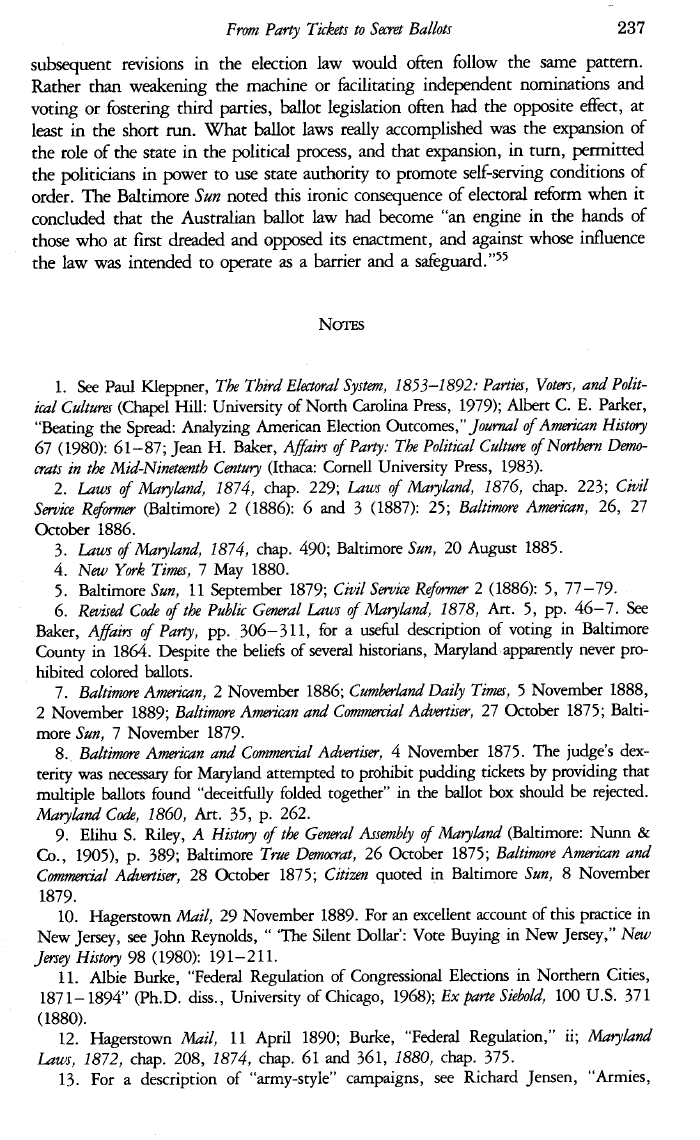|
From Party Tickets to Sant Ballots 237
subsequent revisions in the election law would often follow the same
pattern.
Rather than weakening the machine or facilitating independent nominations
and
voting or fostering third parties, ballot legislation often had the
opposite effect, at
least in the short run. What ballot laws really accomplished was the
expansion of
the role of the state in the political process, and that expansion, in
turn, permitted
the politicians in power to use state authority to promote self-serving
conditions of
order. The Baltimore Sun noted this ironic consequence of electoral reform
when it
concluded that the Australian ballot law had become "an engine in the hands
of
those who at first dreaded and opposed its enactment, and against whose
influence
the law was intended to operate as a barrier and a safeguard. "s5
NOTES
1. See Paul Kleppner, The Third Electoral System, 1853-1892: Parties,
Voters, and Polit-
ical Cultures (Chapel Hill: University of North Carolina Press, 1979);
Albert C. E. Parker,
"Beating the Spread: Analyzing American Election Outcomes," Journal of
American History
67 (1980): 61-87; Jean H. Baker, Affairs of Party: The Political Culture of
Northern Demo-
crats in the Mid-Nineteenth Century (Ithaca: Cornell University Press,
1983).
2. Laws of Maryland, 1874, chap. 229; Laws of Maryland, 1876, chap. 223;
Civil
Service Reformer (Baltimore) 2 (1886):6 and 3 (1887): 25; Baltimore
American, 26, 27
October 1886.
3. Laws of Maryland, 1874, chap. 490; Baltimore Sun, 20 August 1885.
4. New York Times, 7 May 1880.
5. Baltimore Sun, 11 September 1879; Civil Service Reformer 2 (1886): 5,
77-79.
6. Revised Code of the Public General Laws of Maryland, 1878, Art. 5, pp.
46-7. See
Baker, Affairs of Party, pp. 306-311, for a useful description of voting in
Baltimore
County in 1864. Despite the beliefs of several historians, Maryland.
apparently never pro-
hibited colored ballots.
7. Baltimore American, 2 November 1886; Cumberland Daily Timer, 5 November
1888,
2 November 1889; Baltimore American and Commercial Advertiser, 27 October
1875; Balti-
more Sun, 7 November 1879.
8. Baltimore American and Commercial Advertiser, 4 November 1875. The
judge's dex-
terity was necessary for Maryland attempted to prohibit pudding tickets by
providing that
multiple ballots found "deceitfully folded together" in the ballot box
should be rejected.
Maryland Code, 1860, Art. 35, p. 262.
9. Elihu S. Riley, A History of the General Assembly of Maryland
(Baltimore: Nunn &
Co., 1905), p. 389; Baltimore Tare Democrat, 26 October 1875; Baltimore
American and
Commercial Advertiser, 28 October 1875; Citizen quoted in Baltimore Sun, 8
November
1879.
10. Hagerstown Mail, 29 November 1889. For an excellent account of this
practice in
New Jersey, see John Reynolds, " 'The Silent Dollar': Vote Buying in New
Jersey," New
Jersey History 98 (1980): 191-211.
11. Albie Burke, "Federal Regulation of Congressional Elections in Northern
Cities,
1871-1894" (Ph.D. diss., University of Chicago, 1968); Ex paste Siebold,
100 U.S. 371
(1880).
12. Hagerstown Mail, 11 April 1890; Burke, "Federal Regulation," ii;
Maryland
Laws, 1872, chap. 208, 1874, chap. 61 and 361, 1880, chap. 375.
13. For a description of "army-style" campaigns, see Richard Jensen,
"Armies,
|

